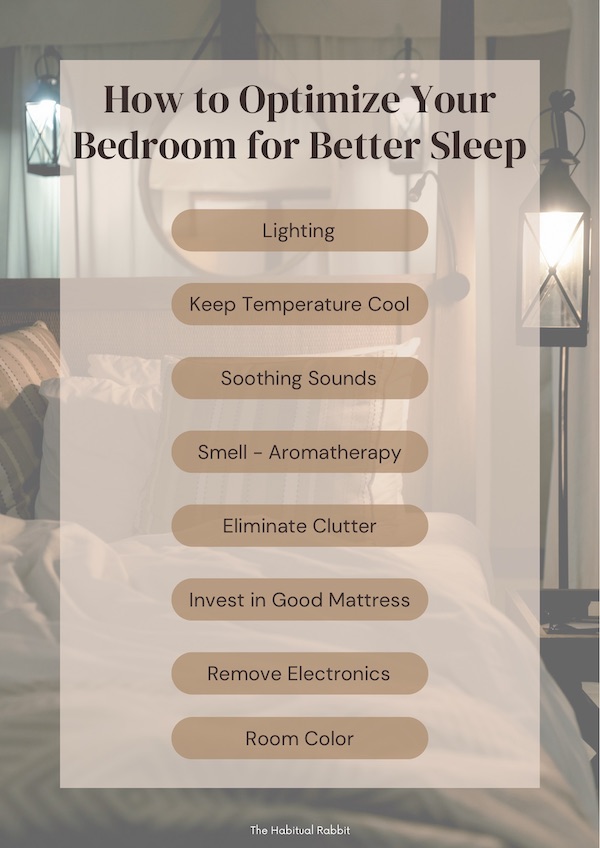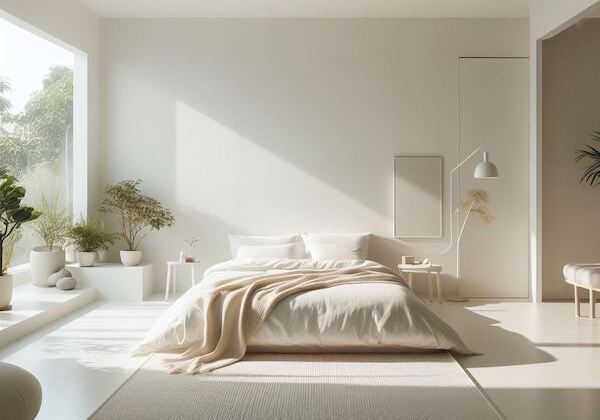
Have you ever walked into a spa and immediately felt lifted off your feet by a wave of relaxation? That’s how I feel every time I go for a massage. Everything about the ambiance just makes all my stressors and worries melt away.
I remember thinking “If my bedroom was like a spa, I would have no problem sleeping!” Then the next thought was the catalyst for my bedroom’s transformation: “Why don’t I just give my bedroom spa vibes?!”
If you’ve ever wondered why it’s so hard for you to fall asleep at night, well, your bedroom environment could be a part of the problem. The bedroom serves as our personal haven, where we unwind, recharge, and escape the stresses of daily life. So it’s important that we’re intentional about the space we want to sleep in. By optimizing our sleep environment, we can enhance our sleep quality, leading to better health, improved mood, and increased productivity.
There are endless ways you can start to optimize your bedroom environment. I’ve narrowed down the top 8 strategies that have worked for me, turning my bedroom into the oasis I’ve always dreamed of. And if that’s not enough for you, these are also science-backed tips.
Let’s dive in!
1. Lighting
One of the most important things that contribute to our internal body clock, a.k.a. our circadian rhythm, is light. It signals to our body when it’s time to go to bed and wake up. That’s why having a dimly lit room a few hours before you go to bed is a crucial step in transitioning into bedtime. And when you are ready to sleep, make sure you’re sleeping in total darkness.
At this point, dim light or a nightlight can interfere with your body’s production of melatonin, which will disrupt your sleep. Consider using blackout curtains, blinds, or even an eye mask when you sleep.
2. Temperature - Keep it Cool!
You’ve probably never thought about temperature as a key factor in getting a good night’s sleep, but believe it or not, sleeping in a cooler room will help you fall asleep faster and improve your sleep quality. The optimal bedroom temperature for most people ranges between 60 and 67 degrees Fahrenheit (15-19 degrees Celsius). You want to make sure it’s cool enough for your body but not too cold.
Our body’s internal temperature naturally decreases during sleep. As it’s connected to our circadian rhythm, setting a cool room is a cue to your body that it’s time to relax and fall asleep. You might notice that you tend to get a bit warmer before sleeping, but that’s just your body’s way of shedding warmth, letting heat escape in order to reduce your core temperature.
Studies also show that cooler bedroom environments also help to support melatonin production, which is your body’s natural sleep hormone. Lowering your core temperature also slows down your metabolism rate, which in turn helps to prevent insomnia but keeps you in deep sleep for longer.
Try adjusting your thermostat or using a fan at night if you don’t want to keep the air conditioner running. Also, experiment with various bedding materials like breathable cotton sheets and blankets that help regulate temperature. Nowadays, mattresses also come with cooling technology that adjusts to your body’s temperature and keeps you cool and comfortable throughout the night.
3. Sound
Generally speaking, noise can disrupt sleep and make it difficult to fall asleep or stay asleep. With that said, everyone is different when it comes to noise. Some people must sleep in absolute silence, while others need white noise or soothing music. It really depends on what works best for you!
Obviously unwanted, loud noises are not ideal when you’re trying to sleep. Imagine having to hear construction sounds at night when you’re trying to get some shut-eye… what a nightmare!
However, soothing nature sounds, instrumental music, or guided meditations can create a more peaceful and relaxing ambiance, promoting a calmer state of mind that will help ease you into sleep.
Personally, I don’t like complete silence. I like having peaceful, instrumental music or white noise on when I’m trying to fall asleep. My go-to is finding a “spa playlist” on Spotify about 30 minutes before I go to bed and just letting it play through the night; it really gives me the spa vibes I’ve been telling you about!
On the other hand, Kevin has to sleep in silence. So he wears soft earplugs that block out any noise while I play my music quietly. You’ll have to find what works best for you… and your partner!
4. Smell
I’m big on scents.
If smell is not important to you, then you can skip this part. BUT I will say this.
Aromatherapy can be a powerful tool for relaxation and improving sleep quality.
Certain scents, such as lavender, chamomile, and jasmine, have been proven to have calming effects. If you want to turn your bedroom into a true oasis, try using an essential oil diffuser or scented candles (but blow them out before you sleep for safety reasons). Just as important, make sure you have proper ventilation and avoid overpowering scents that may cause discomfort.
I like to alternate between a scented candle and a diffuser. If you need recommendations, my favorite scents to use are lavender, eucalyptus, and lemongrass. Remember, spa vibes.
5. Eliminate Clutter
This is a big one. It’s hard to relax your mind when all you see is clutter when you step into your sleep sanctuary!
A cluttered bedroom can lead to a cluttered mind, making it challenging to relax and fall asleep. Keep your sleep sanctuary organized and free of unnecessary items. This means no unfolded laundry all over your bed, random items on the floor, and unpaid bills on your nightstand. Optimize storage space in your room and keep personal belongings neatly tucked away.
A tidy bedroom promotes a peaceful state of mind, which allows you to let go of the day’s worries and drift into restful sleep. No one wants to look at a stack of bills, letters, and paperwork when they’re trying to fall asleep.
6. Invest in a Good Mattress
This is one I learned as I got older and is especially important if you have neck and back problems like me.
Investing in a comfortable and supportive mattress and bedding is extremely crucial for achieving quality sleep. I didn’t realize this until I started developing back problems due to poor posture. My old mattress and pillows did not have enough support, so I would go to bed achy from the workday and wake up in even more pain… it was unbearable!
Consider opting for a mattress that aligns with your preferred sleeping position and provides adequate pressure relief, especially if you’ve got back pain. Additionally, select pillows that support your neck and head in a neutral position. Choose breathable and hypoallergenic bedding materials to enhance comfort and prevent allergies or skin irritations.
All of these things may seem small, but as you get older, you’ll notice a significant difference in your sleep quality.
7. Remove Electronics
It’s time to banish your TV, laptop, and phone from your sleep sanctuary!
Okay maybe not your phone, some of us like to set alarms on our phones. But try to keep it away from your sleep space and put it in a different part of the room that you can’t reach.
As mentioned in our previous articles, electronic devices are a huge no-no when it comes to sleep time. Electronics emit blue light, which can suppress the production of melatonin, a hormone that regulates sleep. This means that it’s going to take longer for you to fall asleep and you might not even stay asleep for very long. It could also contribute to poor quality sleep, making you feel even more tired when you wake up.
I know it’s tempting to have a TV in your bedroom and just watch some shows before you fall asleep. Some of you might even have the TV on because the noise helps you sleep. I get it, but trust me, this is not great for your long-term sleep quality.
All sleep experts will tell you this: avoid electronics at least one hour before bedtime. Instead, engage in some calming activities like reading a book or guided sleep meditation to prepare your mind and body for sleep.
8. Room Colors
Believe it or not, the colors in your bedroom can influence your mood and sleep quality. If you’re looking to do a full transformation of your bedroom, you might want to consider repainting the walls for an optimal sleep environment.
But what are the ideal colors?
Opt for soothing, neutral tones like soft blues, greens, or earthy hues, which create a tranquil atmosphere. These colors have been shown to promote relaxation and lower heart rate and blood pressure. Avoid bright and stimulating colors that can be energizing and hinder your ability to unwind.
This might not be as important, but again, it’s all in the details.

Final Thoughts
Creating a sleep sanctuary in your bedroom can significantly improve the quality of your sleep and enhance your overall well-being. It feels great to come home after a stressful day and be able to immediately relax and unwind as soon as you step into your bedroom.
If you want to create a sleep oasis, then consider optimizing the lighting, temperature, sound, smell, clutter, mattress and bedding, and room colors, and removing electronics from your bedroom. These science-backed tips will significantly change the way you sleep. So say goodbye to restless nights and hello to the peaceful and revitalizing sleep you deserve.
